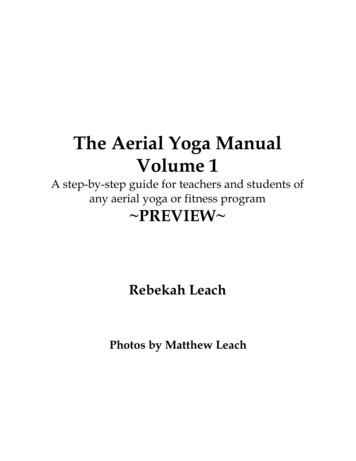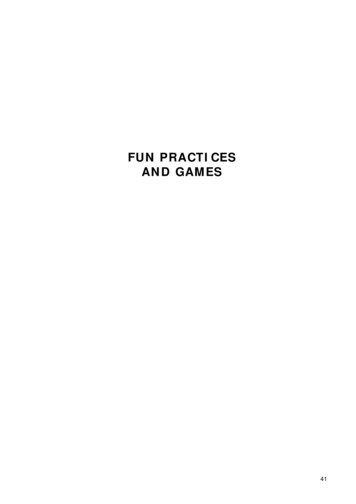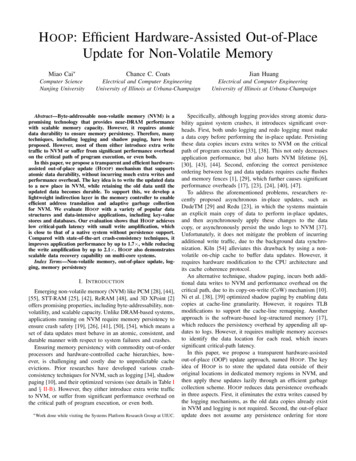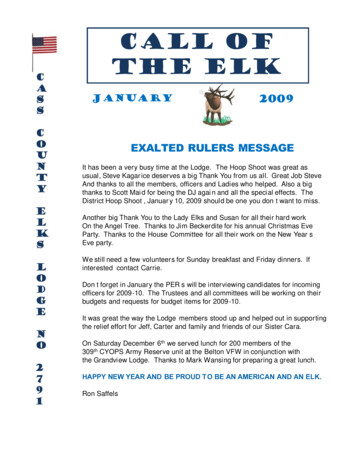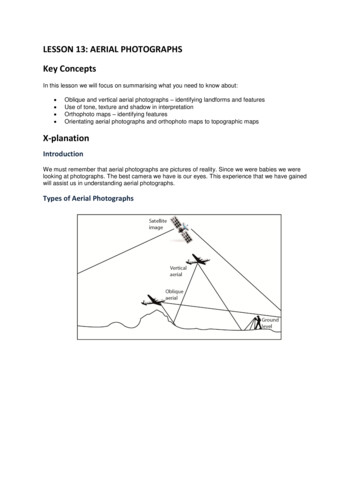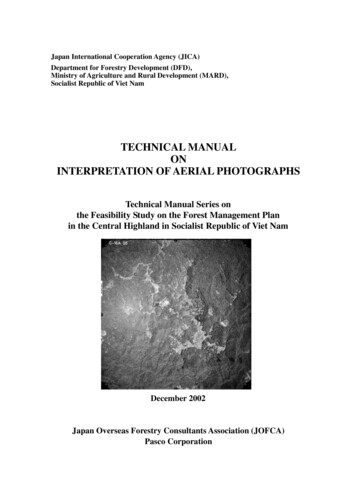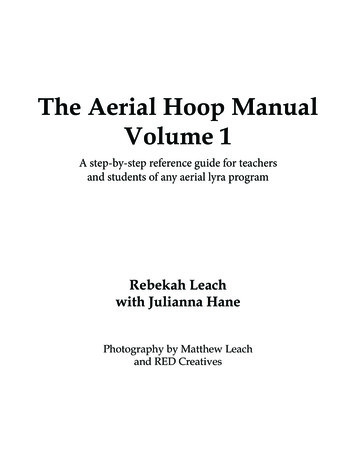
Transcription
The Aerial Hoop ManualVolume 1A step-by-step reference guide for teachersand students of any aerial lyra programRebekah Leachwith Julianna HanePhotography by Matthew Leachand RED Creatives
DisclaimerThis manual is not intended for a layperson to pick up and start learning on their own.All use (and misuse) of this manual is done so AT YOUR OWN RISK.Check with your healthcare professional before inverting and going into positions that cause pressure to certain places on the body. For example, those with heart conditions and/or inner ear issuesshould not invert as it is a dangerous situation which can cause stroke, heart attack, dizzy spells, orfurther injury, including death. As with any exercise program, there is always a risk of injury. Also,working at any given height adds an increased risk of injury, including paralysis or death.Be SafeThe top 10 things you can do to make sure that you are practicing safely:1. Start by taking live lessons from a professional aerialist. Use this book for reference only.2. Always check your rigging.3. Always practice over a mat.4. Never practice alone. Always have a spotter.5. Always perform a solid warm-up prior to mounting an aerial apparatus.6. Practice safe progression. (If you do not have the required strength, do not attempt the move.)7. Don’t make guesses. If you are not sure if something is going to “work,” don’t try it!8. Focus on injury prevention exercises early in your training.9. Pay attention to proper positioning of your shoulders at all times.10. Listen to your body. Take care of it and it will take care of you.
All rights reserved.No part of this publication may be reproduced, stored in a retrieval system, or transmitted in any way or by anymeans, electronic, mechanical, photocopying, recording or otherwise, without the prior written permission ofRebekah Leach.This book may be purchased with bulk discounts. For information, send an e-mail to: info@aerialdancing.com.Corresponding video content is coming available on AerialDancing.com.When practicing aerial hoop, always perform warm up exercises before attempting any individual exercises. Also,when practicing aerial hoop, always do so in the presence of a trained professional, with load-tested aerial equipment hanging from load-tested rigging, which has been set-up and inspected frequently by rigging professionals,along with crash pads underneath the hoop. It is recommended that you check with your doctor or healthcare provider before commencing any exercise program, especially one as rigorous as aerial hoop.Whilst every care has been taken in the preparation of this material, there is a real chance of injury in execution ofthe movements described in this book. The Publisher and all persons involved in the making of this manual will notaccept responsibility for injury to any degree, including death, to any person as a result of participation in the activities described in this manual. Purchase or use of this document constitutes agreement to this effect. Furthermore,rigging of aerial equipment is not discussed in this manual. Consult a professional rigger when it comes to usingany hanging equipment.Published by Rebekah LeachUnited States of AmericaFirst EditionCopyright 2013 by Rebekah Leach
Table of ContentsC harpteFrom the Authors viIntroduction viii1Foundational Moves 1Grip Holds 2Shoulder Positioning 4Some Warm Up Stretches & Exercises5Pulling Taffy & Sweet Spot Exercises6Pull Ups & Lock Offs 7Long Hang on Top BarC haSteering the Hoop 9Familiarization/Exploration Tour 10rpte82Under the Hoop 15Ball/Tuck Inversion 16Pike Inversion 17Straddle Inversion 18Double Knee Hang & Beats19Splits Under Bar 20Arrows & Tofu Hook 21Single Knee Hang with Hand, Elbow, etc.22Single Knee Hang 23Half Hip Hang 24Hip Hang to Single Leg Block25Bird’s Nest 26Ankle Hang 27C haProfile Ankle Hang (a.k.a. Running Man or Scissors)29rpteCandlestick 283Mounting the Hoop 31Vine Climb 32Single Knee Mount 33Tuck Mount 34Straddle Mount 35Belly Roll 36Pull Over to Hip Hang37Backwards Roll Up (Pull Over to Horse)38Pull Up from Bird’s Nest39
C harpte4Beginning Moves in the Hoop41Sitting Family 42Layback Family 43Splits Down (Hang on Top Bar Family)44Horse and Stag Family 46Lean Out Family 47Star/Arabesque 48C ha49(Front) Lion in a Tree/Sleeper50Mermaid Family (& Angel Roll)52Intermediate Moves in the Hoop55rpteMan in the Moon (Profile Sit Family)5Reverse Lion 56Front Hip Balance Family 58Popsicle Family 59Amazon 60Dragonfly61Knee Hang on Top Bar Family62Foot Block 63Gazelle (Profile Laybacks)C haBack Balance Family 65rpte646Transitions 67Momentum Movement 68Transverse Transitions 69Coronal (Frontal) Transitions 70Sagittal Transitions: (Rolls) 72Lion to Lion (same face and change face)74Press Support Transitions (& Dragoncatcher)76Gazelle Transitions 77The Physics of the Hoop79Choosing the Right Hoop 80Index 82About the Authors 84Acknowledgments 86
From the AuthorsDear Reader,How I wish you could have been present for allthe conversations Julianna and I had during themaking of this book. We talked about so manyideas, but putting them all into this book wouldeither overwhelm you or bore you to death. ButI can assure you of our conclusions: There are amillion and one ways to apply the knowledgethat we present in this manual.Sometimes our conversations centered aroundthe differences between how the progressionsmake sense for a linear organization in a manual versus the progressions for teaching in theclassroom. These are two very different ways oforganizing material, and it is impossible to cover the latter in a book, since the way you teachthis material will vary so widely depending onthe background of the students. On that note, Iwould not be surprised if our next collaborationinvolved a book on aerial teaching philosophies. We have already incorporated many successful initiatives into our teaching styles, andJulianna has seen tremendous improvement inher retention rate.Sometimes our conversations were about whatthe ideal aerial career looks like to each of us.Aerialists tend to make a living through eitherteaching or performing, but for many it is amixture of both. Through the purchase of thisbook you have helped me come one step closerto my ultimate dream career. All of my profitsafter tax—of all of the manuals that I have written—are currently going into a fund that willbuild and open an aerial dance studio when thetime is right. I had a small aerial dance studioonce. It could not survive financially, and I longto have a studio that can. It was a gift to takethe journey that I did because these manualshave been a part of it, but how I wish to just bean aerial teacher and choreographer once more!Now here is how this book can be a gift toyourself: To really glean the magic of this book,you must put it into practice. Put the words onthe page into your body. Make it come alive foryourself. You will be blessed.Of course have fun, but always play it safe sothat you can continue dancing long into yourold age. The only two injuries I have had inmy last three decades of dancing have been onhoop. One injury happened years ago when Iwas being pressured under a director to perform to a level that my body was not at. Myshoulder blade did a weird pop into my backrib cage, and years of physical therapy simplykeep the pain at bay. The second injury wasmore recent: After the birth of my daughter, Iwas rushing back onto hoop, and didn’t listento my body like I should have. I was in the candlestick position and decided to let go againstmy inner voice telling me not to. My kneepopped, and while it is healed, now and then Inotice its weakness.Getting injured has helped me be a betterteacher because it has encouraged me to take alonger look at the risk factors of various moves.I have learned my lesson in the importanceof listening. If I had done that, it would haveprevented both of my injuries. The best safetylesson we can teach is listening to our bodies.Go slow. Some lessons will feel painfully slowto both the student and/or the teacher. Both ofyou just need a dose of patience, and have itwith yourself as well as those who are a part ofyour journey. Some days you just need to rest,and stop when your body says stop.Despite or perhaps because of the risks, the lyrais a powerful apparatus. It shows off flexibilityand strength in ways unlike any other apparatus. It can also show off pure gracefulness. Picka move, start spinning and you have yourselfyour first piece!I have my own reasons for why I enjoy workingwith the lyra, but I also want you to hear fromJulianna. While she started out loving fabricand scared to death of hoop, now the lyra is her“aerial home.” She has a great passion for it,which her students get to enjoy learning from.Her comments and reflections about how to
photography by Ryan Woolseyteach aerial hoop has been a great help to methroughout this process. I turn you over to hernow, to hear more about her story:“I was a dedicated fabric person for several years,having taught all levels and performed in a varietyof venues. After all, everyone loves fabric, right?It’s impressive, fluid, graceful, and soft. I had littleinterest in hoop because it gave me bruises and feltunstable. How could I possibly like an apparatusthat doesn’t mold to my body? It just didn’t makesense to me.Aerial dance pulls at my heartstrings because itcombines grace with daring. I’ve always wantedto be a more daring person. I tend to be quite shy.So while I avoided the most frightening apparatusfor a while, a mentor came along (Tandy Beal) andsuggested I try hoop because it seemed like a good fitfor my body.I trained briefly with a Russian coach (Elena Panova) who made me to do some pretty scary moves.There was no questioning her authority – I justhad to do what she told me. And that was the mostamazing gift. I wasn’t allowed to think or overthink – just do and do again. Let go, reach, catch. Itwas a simple existence that forced me out of my headand into the moment.Learning to work the spin was another beast. Iwanted/needed to gain more control over the spin.So another teacher (Aimee Hancock) told me to letgo of my agenda and let the spin lead me. Wait I’m supposed to be in control, right?But then I realized it’s not really about me it’sabout connecting with something greater than myself. The practice of listening to the hoop has beenone of the most mind-blowing experiences for me.Practicing yoga and contact improvisation on solidground has also helped.For me, aerial hoop isn’t really about learning newskills it’s about learning to live life a little better. Ihave bonded with the hoop because it has helped mebecome a more truthful version of myself. And forthat I am truly grateful. I hope that aerial hoop willgive you as much as it has given me.”Enjoy exploring the art of aerial hoop throughthis manual. I hope this book helps you betterdo what you love.Happy Flying,Rebekah and Julianna
Grip HoldsPrerequisite(s):Ready to buildcallusesAbout this move: The grip test will put your hands to the test, so take care of those hands. Our favoritehand treatments include ice after a long workout (a cold beverage works well), and holding wet black tea bags.The tea tans the skin and makes it thicker like leather. Hold the tea bags for five minutes per hand, and repeatas often as you like. On the flip side, you can use lotion to soften calluses - just not while you are in class!Get a Grip on GripGripping a metal hoop can cause discomfort at first. The skin at the top of the palm will fold under creating pressureand building calluses. (For that reason, it is best to remove all rings.) The good news is that our bodies are adaptable,and you can get used to the grip. It is also completely normal to get a “flash pump” in the forearms from gripping thehoop over periods of time (the term “flash pump” is borrowed from rock climbing – the arms build up lactic acid suddenly and become unusable). Drop the hands and shake the arms out to relieve some of the pressure.To help reduce forearm soreness: Hold your arms straight out in front of you. Make fists, roll them under towards you,then out and extend hands forward, opening up towards the ceiling, and extend your fingers. Repeat slowly for severalminutes. Add this exercise into your warm up routine to help build stamina. Also, drink plenty of water (and make sureyou are getting all your needed nutrients) to keep all your muscles in peak working condition.1Overhand GripHold onto the hoop with the knuckles facing you andfingertips facing away. Always wrap the thumbs underthe bar. Your hands may be at varying distances apartdepending on what move you are preparing for. The wideryou hold your hands on a hoop, the more stress can beplaced on the wrist from gripping the curve. Other factorsalso come into play such as having a smaller hoop, wherethe curvature is greater.On the hoop, it is the default grip for moves that are inthe hoop/on the top bar (i.e. moves above the horizon linewhere the concavity is downwards). In below the hoopmoves, you are more likely to see an underhand grip beingused amongst dancers.Training Tip: Pull ups are a great way to build your gripstrength and vice versa. They go hand in hand.8Chapter 1: The Foundation2Underhand GripHold onto the hoopwith fingertips facingyou and the knucklesfacing away. Wrapthumbs under the bar.You may find this gripto be your personalpreference for movesunder the bar due toless wrist strain. It alsoallows you to use yourbiceps, which makesthis method easier. Justmake sure to work bothgrip methods so thatyou will be ready for allmovements.3Opposite Facing GripStanding profile to the hoop,hold onto the hoop so thatyour hands face differentdirections.Once you have hand gripsconquered, you can play withletting go with one hand.Practice a little bit of weighttransfer at a time. Graduallywork up to holding all yourweight on one hand.(From hanging on two hands)When you let go with onehand, one of two things mighthappen: your hoop spins oryou spin. Because of the swivel, it’s typically the hoop.
Tuck MountPrerequisite(s):Double KneeHang1About this move: The tuck mount is the perfect symmetrical mount, meaning your body can remain inmirror symmetry for the duration of the movement. For that reason, it is a perfect addition to conditioningroutines. You can use beats swings under the hoop as a way to get into this mount, but add those in after youhave the foundation of this movement.2354From a Knee Hang Prep to Gripping the HorizonBegin with a prep for a knee hang by placing the backs of your knees on the lower bar. Underhand grip can be used sothat you do not have to switch your grip in the coming steps. Using shifts of momentum, get your hands higher on thehoop. These shifts in momentum can be either little rocks to inch your hands up the hoop or a big sweeping motion ofthe body in knee hang beats (covered in chapter two). If you use knee beats, the momentum from the swing will allowyou to grab the horizon of the hoop in one motion. At this point, you need to have your grip around the outside of thehoop in order to safely pull your body towards the hoop. Spotters: Have the hands under the back to help as needed.One hand protects the upper back/head, while the other supports the hips.6OR789Seesaw Motion to Sitting in the HoopOnce your hands are close to or above the horizon line of the hoop, you have two options for the seesaw motion: (Photo 6) straighten both legs or (Photos 7 & 8) straighten one leg. It can be helpful to learn/teach the straight leg methodfirst so that you learn how the body weight shifts here. The seesaw motion is so named because you begin with thepevlis low and the feet high before throwing the legs down to lift the pelvis up. Push your legs down into the bar as youslide to a sitting position. This seesaw action should bring you directly up to sitting without too much bicep action.9Chapter 3: Mounting the Hoop
Mermaid Family (& Angel Roll)Prerequisite(s):Laybacks (a.k.a.the lean family)About this move: In the mermaid family, the legs are tightly held together as if forming a mermaid’s fishlike tail. In the outside mermaid, the body rolls away from the hoop so that the front of the body is exposed tothe outside. In the inside mermaid, the body lays parallel to the hoop, with the front of the body on the “inside,” next to the hoop. The crossed-legged mermaid is a variation of outside mermaid.Outside MermaidOutside mermaids can feel quite exposed when first trying them because the body rolls away from the hoop with only minimal support at the thigh and gripping hand. The hoop also tends to move a great deal during the thigh rolling process, so rolling towards aspotter’s arms is helpful for beginners.13245An ExitOutside MermaidBegin in a sitting position with one hand at 1 or 11 o’clock. Laybackwith the legs together. For assistance as you roll, reach behind yourbody with the free hand to grip the hoop. Then roll onto one thighso the legs are stacked. Reach the back arm out away from the hoopand arch the upper back. For a deeper mermaid position, begin withthe hand slightly further away from the anchor point. This allowsthe torso to drop further and create a bigger arched position. To exitdrop the pelvis as you reach back to return to the sitting position.Inside Mermaid123An ExitInside MermaidBegin in a sitting position with the side hand in overhand grip and the tophand in an underhand grip. Lean sideways, passing the hands until the armsare straight. The weight will transfer from your sitz bones to your bottomthigh. Release the bottom hand and reach away from the hoop. To exit, bringyour torso toward the hoop and pike at the hip joints. Drop the pelvis toreturn to the sitting position.10Chapter 4: Beginning Moves in the Hoop
Crossed Legged Mermaid (from Man in the Moon Profile Sit)1324Exit to Sitting: GripCrossed Legged MermaidBegin in man in the moon with legscrossed. Notice which leg is on top,and grip with the same hand high onthe hoop. Grip behind your lower backwith the other hand. Straighten bothlegs, and keep them as close togetheras possible. Rotate the body away fromthe hoop, squeezing the legs together.Release the bottom hand (from behindyour back) and reach out into space.the top of the hoop with bothhands and bend the knees. Turnback into a sitting position.Exit to Sleeper: Grip the topof the hoop, then bend the knees anddrop the pelvis down to enter sleeper.Angel Roll from MermaidAngel Roll(Mermaid Extension)Begin in a sitting position withone hand at the top of the hoop(just like going into regular outside mermaid). As you lean foran outside mermaid, bend thetop leg bringing it through thehoop and down in front of yourbody. It will take some practiceto find just the right spot to rollto on your thigh. Rotate as far asyou safely can, and then extendthe free leg if you would like.13245Alternate ViewExit to SittingIn the roll back to the sitting position, the secret is inthe drop of the hips. This prevents a roll to the backwhich is perfect for a transition into dragonfly, butnot so great for the retrograde of the angel roll.Chapter 4: Beginning Moves in the Hoop11
Gazelle (Profile Laybacks)Prerequisite(s):L-sitAbout this move: Gazelles are traditional moves performed on trapeze. If you are used to performing gazelleon a trapeze, then transitioning to hoop will feel strange at first due to the curvature of the apparatus. Newaerial students may want to learn gazelle on a trapeze before trying it on hoop since the ropes of a trapezeallow for more movement and adjustments in the aerialist’s body.GazelleBegin in an L-sit. Bend the bottom leg toward yourchest. Lean back and shift your hands so that yourbody ends up on one side of the hoop and yourbent leg on the other side. Lift and shift your pelvisover so that your sacrum ends up centered on thebottom bar. Some aerialists prefer to lean back,bend the knee, and shift the pelvis all at the sametime. Hug the bent knee into your chest. Pressyour straight leg into the other side of the hoop forstability. Continue holding onto the knee with thesame side arm (right arm if the right leg is bent) asyou release the other arm and lower the torso belowthe bar. Press the inner thigh of the front leg firmlyinto the bar. If you feel secure in this position andyour sacrum remains centered on the bar, releaseboth hands. Spotters: Hold under the back andshoulder when the student releases the arms.PLAY TIME!Explore the many variations within this move-one bent leg with one straight leg, and vice versa,or bend both legs; try grabbing feet, twisting torso,etc. For a gazelle split, grab the heel and straightenthe front leg. Be sure that your back leg has notlost constant pressure with the hoop.123456An ExitThere are many transitions fromthis position (see chapter six),but for now simply retrogradethe position by climbing back upthe hoop hand over hand.Spotters: Hold under the shoulders during the movement.12Chapter 5: Intermediate Moves in the Hoop
Index1/2 Mill Circles 38, 73Knee Hang Beats 19Amazon 60Knee Hang on Top Bar FamilyAngel Roll53Layback Family 43Ankle Hang 27Lean Out Family 47Arch Back Pose 1,2,3Lion in a Tree 506262Arrows 21Lion to Lion (same face and change face)74Back Arrow 21Lion to Half Hip Hang72Back Balance Family 65Lock Offs 7Backwards Roll Up38Long Hang Beats68Ball/Tuck Inversion 16Long Hang on Top Bar8Belly RollMan in the Moon (Profile Sit Family)4936Bent Arm Hang 4Mermaid Family 52Bird’s Nest26Mill Circles 73Candlestick 28Momentum Movement 68Coronal Transitions 70Monkey Rolls73Crossed Legged MermaidOne Hand Grips253Double Knee Hang 19Opposite Facing Grip 1Dragoncatcher 76Outside Knee Hook 22DragonflyOutside Mermaid 5261Dynamics of Spinning 33Overhand Grip 1Familiarization/Exploration Tour10Phrasing Exercises43Foot Block 63Pike Arrow21Forward Rolls: Mill Circles73Pike Inversion17Front Hip Balance Family58Popsicle Family59Front Hip Balance Exercise58Press Support Transitions76Front Hip Balance to Outside Knee Hang73Profile Ankle Hang29Front Roll: Lion to Half Hip Hang72Pull Over to Hip Hang37Frontal Transitions 70Pull Up from Bird’s Nest39Full Body Back Balance65Pull Up in Lunge5Gazelle 64Pull Ups7Gazelle Transitions 77Pulling Taffy Exercise6Grip Holds 1Reverse Lion56Half Hip Hang 24Running Man29Half Hip Hang Splits24Sagittal Transitions (Rolls)72Hip Hang to Single Leg Block25Shoulder Positioning4Hip Hang to Sitting with L-pop71Shoulder Shrugs in Hoop45Hip Hang to Sitting: Rigid Roll70Shoulder Stretch (Forward Fold)5Horse Family 46Shoulder Stretch with Span Set, Etc.5Horse to Horse 69Single Knee Hang 23Horse/Stag Entrance to Half Hip HangSingle Knee Mount 3372Inside Mermaid 52Single Knee with Hand, Elbow, etc.22
Sitting Family 42Sitting on Top of a Double Tabbed Hoop13Sitting to Hip Hang: Rigid Roll70Sitting to Hip Hang: Through Mermaid71Sitting to Long Hang Behind Hoop69Sleeper 51Splits Down (Hang on Top Bar Family)44Splits Down Behind the Hoop44Splits Down in Front of Hoop45Splits Under Bar20Stag Family 46Stag Back Balance 65Standing Up from Toe Squat12Standing with Arms through Double Ropes13Star/Arabesque 48Steering the Hoop 9Straddle Back Balance 65Straddle Inversion 18Straddle Mount 35Straight Arm Hang 4Straight/Vertical Arrow 21Sweet Spot Exercise6Tofu Hook 21Transverse Transitions 69Trashcan to Toe Squat 12Tuck Mount 34Twirls 68Underhand Grip1Vine Climb 32Warm Up Stretches & Exercises5Washboard Abs 5BibliographyGuest AH, Curran, T. Your move. New York: Routledge, 2008.Hackney P. Making connections: total body integration through Bartenieff fundamentals. NewYork: Routledge, 2000.Lippert L. Clinical kinesiology and anatomy. Philadelphia: FA Davis Company, 1942.Kendall FP, McCreary EK, Provance PJ, et al. Muscles: testing and function. Baltimore: Lippincott Williams &Wilkins, 2005.
About the AuthorRebekah Jean Leach has been dancing for over three decades now.Anywhere she is, is her stage, starting with the fireplace hearth whenshe was 3 years old. In college, she took her first official course indance. On the wall, was a picture of dancers dancing in ropes. Shefelt the urge—the calling, if you will, to higher ground. At age 22, sheattended a workshop by Fred Deb held at the Aerial Dance Festival inBoulder, CO. Before the festival, she attended a performance of FredDeb’s with the Colorado Symphony Orchestra. That performancechanged the course of her life.In 2008, Rebekah and Matthew Leach opened an aerial dance studioin Ojai, CA. Rebekah combined her background in education withteaching her love of aerial dance. However, when the recession hit,and Matthew was laid off from his job, hard times hit. Plan B wentinto action. Relying on her technical background, Rebekah joined theNavy, where she is currently a commissioned officer teaching nuclearphysics at the Nuclear Power Training Command in Charleston, SC.When her active duty commitment is complete, her dream is to onceagain open an aerial dance studio. All of Rebekah’s profits from thesales of these manuals are going towards that end. Thank you forhelping dreams come true.Rebekah currently lives with her loving husband, Matthew and adorabledaughter, Naomi, in Charleston, SC.
About the Contributing AuthorJulianna Gaillard Hane, a native of South Carolina, traded life on a cotton farm to be a dancer and aerialist. Julianna’s first experience in aerialdance happened at Winthrop University (where she received a B.A. inDance) when she performed in two rope & harness works by Mary BethYoung. She then continued her study of aerial work at New EnglandCenter for Circus Arts with Elsie Smith, Serenity Smith Forchion, andAimee Hancock. She has also studied with Bay Area artists Joanna Haigood and Elena Panova.Julianna holds a M.F.A. in Modern Dance from the University of Utah.During her graduate study Julianna founded Revolve Aerial Dance, aschool and performing company specializing in aerial fabric, trapeze,and aerial hoop. Through the company she co-produced aerial concerts,performed in corporate events, and set an aerial dance work on theSnow College Dance Company in Ephraim, Utah. She wrote her master’s thesis on aerial dance choreography under the guidance of DonnaWhite, Eric Handman, Abby Fiat and Tandy Beal. She also wrote anaerial dance curriculum for her studio and a teacher training course tomentor new aerial teachers. This manual has been an extension of thatwork.Julianna moved Revolve Aerial Dance to Charleston in 2010 to collaborate withlocal dancers, musicians, writers, and other artists in her home state.
AcknowledgmentsMore people helped with this manual than all of my previous manuals combined. This wasone of reasons that I feel that this manual has turned out to be the best manual I have workedon thus far. This manual, more than any others, reflects not just my own work as an artist, butthat of the entire aerial lyra community. (Another thing that helped make this manual awesome was access to better programs to help design it! I created the other manuals in a programnot meant for books, and they were formatting nightmares. Now I have to go back and reviseall my old manuals. Ah, the list of things to do.)The aerialists directly quoted in this manual are: T Lawrence-Simon (hoopartist.com), RachelStewart, Liz Cooper, Jerusha “Juice” Horlick, and Clayton Woodson. I appreciate their work asaerial teachers, and am delighted to have their contributions in this manual.Some others who were not quoted directly, but whose stories helped inspire me and get me outof writer’s block include Julie Wood, Jessica John, and Jordan Anderson. Much thanks goes outto Julie Marchand for coming over and helping with a photoshoot one day. Jordan Andersonand Clayton Woodson were among the aerialists who would get together with Julianna andmyself to brainstorm teaching ideas. It was super helpful!Thank you to many others in the lyra community, especially those on Facebook who kept helping me figure out what the most common names for poses are. You have all helped in one wayor another contribute to this book’s creation!The editing process for this manual was particularly needed. I have lost my touch for the details after becoming a frazzled mom. I am thankful so many people were willing to help editfor both grammar and content. At first, I thought we had too many people looking at the bookat once, but all of them found different kinds of errors. Clayton Woodson, Jordan Anderson,Catherine Saldana, and Julianna Hane all helped with the editing process. Thank you!This was my first attempt at co-authoring with someone by my side as I went through thisprocess, and it has been absolutely wonderful! I am so happy that Julianna Hane joined me forthis adventure. Her words are completely intertwined with mine to say everything better thaneither of us could have said it alone. I cannot wait to do more collaborations with her and withother artists.And of course, last but not least, my amazing, talented, supportive, loving, dedicated husband,Matthew Leach. He keeps me blessed as well as balanced.
Aerial Dance Manuals by Rebekah LeachBeginning Aerial Fabric Instructional ManualIntermediate Aerial Fabric Instructional Manual Part 1Intermediate Aerial Fabric Instructional Manual Part 2Aerial Yoga Manual Volume 1Aerial Yoga Manual Volume 2Aerial Hoop Manual Volume 1Aerial Hoop Manual Volume 2 (coming soon)Advanced Aerial Fabric Instructional Manual (coming soon) Corresponding video content to all man
Profile Ankle Hang (a.k.a. Running Man or Scissors) 29 Mounting the Hoop 31 Vine Climb 32 Single Knee Mount 33 Tuck Mount 34 Straddle Mount 35 Belly Roll 36 Pull Over to Hip Hang 37 Backwards Roll Up (Pull Over to Horse) 38 Pull Up fr



